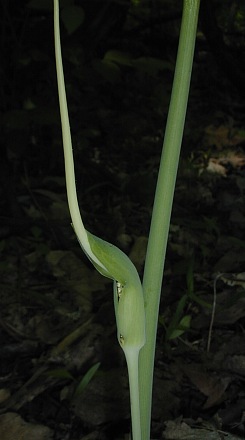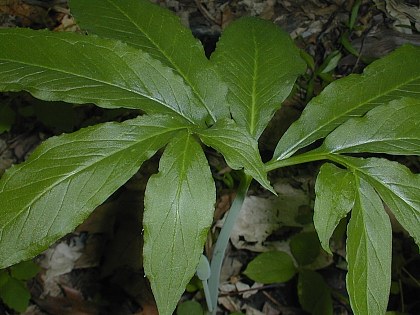 Description:
This herbaceous perennial plant is 1½–2½' tall. It consists of a single
basal leaf and single flowering stalk. The basal leaf has a long stout
petiole that is up to 2' long and erect. This petiole is pale green,
glabrous, and glaucous. The basal leaf is up to 2½' long and 2' across;
it divides into 5-13 leaflets that are parallel with the ground. Each
leaflet is up to 8" long and 2½" across, narrowly ovate, smooth along
the margins, glabrous, and dark green. The 2 terminal leaflets may be
deeply cleft into 2 or 3 lobes that resemble smaller leaflets. The
naked flowering stalk is about ½–1' tall (not including the flower); it
is whitish green, unbranched, erect, and hairless. At the apex of this
stalk is a single flower that consists of a spathe and spadix. The
spathe is about 2" long, pale green, glabrous, and glaucous. This
spathe wraps around the base of the spadix, but it is partially open
and pointed at the top. The spadix is about 6-12" long. The lower
portion of the spadix is about 2" long and nearly surrounded by the
spathe; it is cylindrical in shape and bears the male and/or female
flowers. Most plants are monoecious with separate male and female
flowers, but sometimes they are unisexual. The male flowers occur above
the female flowers; they are both rather small and inconspicuous. The
upper portion of the spadix is about 4-10" long and tapers gradually to
a point. It is usually whitish green and remains more or less erect.
The blooming period occurs during late spring and early summer and the
flowers remain attractive for about a month. They may release a
fungus-like scent that is not detectable by the human nose. Each flower
is replaced by an ovoid mass of berries, which become orange-red by the
end of the summer. The root system consists of a corm with secondary
roots. This plant can spread by forming offsets or by reseeding itself.
Description:
This herbaceous perennial plant is 1½–2½' tall. It consists of a single
basal leaf and single flowering stalk. The basal leaf has a long stout
petiole that is up to 2' long and erect. This petiole is pale green,
glabrous, and glaucous. The basal leaf is up to 2½' long and 2' across;
it divides into 5-13 leaflets that are parallel with the ground. Each
leaflet is up to 8" long and 2½" across, narrowly ovate, smooth along
the margins, glabrous, and dark green. The 2 terminal leaflets may be
deeply cleft into 2 or 3 lobes that resemble smaller leaflets. The
naked flowering stalk is about ½–1' tall (not including the flower); it
is whitish green, unbranched, erect, and hairless. At the apex of this
stalk is a single flower that consists of a spathe and spadix. The
spathe is about 2" long, pale green, glabrous, and glaucous. This
spathe wraps around the base of the spadix, but it is partially open
and pointed at the top. The spadix is about 6-12" long. The lower
portion of the spadix is about 2" long and nearly surrounded by the
spathe; it is cylindrical in shape and bears the male and/or female
flowers. Most plants are monoecious with separate male and female
flowers, but sometimes they are unisexual. The male flowers occur above
the female flowers; they are both rather small and inconspicuous. The
upper portion of the spadix is about 4-10" long and tapers gradually to
a point. It is usually whitish green and remains more or less erect.
The blooming period occurs during late spring and early summer and the
flowers remain attractive for about a month. They may release a
fungus-like scent that is not detectable by the human nose. Each flower
is replaced by an ovoid mass of berries, which become orange-red by the
end of the summer. The root system consists of a corm with secondary
roots. This plant can spread by forming offsets or by reseeding itself.
Cultivation:
The preference is dappled sunlight during the spring and light shade
during the summer. The soil should be moist and loamy with a layer of
decaying leaves. This plant adapts to shady areas underneath trees and
doesn't like to dry out. It has few problems with disease and insect
pests.
Range & Habitat:
The native Green Dragon occurs occasionally throughout most of
Illinois, although
it is uncommon or absent in the NW area of the state (see Distribution
Map). Habitats include moist deciduous woodlands, shady
seeps, and wooded areas adjacent to springs and vernal pools. The
presence of this species is an indication that the original woodland
flora is still intact. Green Dragon often occurs in the same habitats
as the closely related Arisaema triphyllum
(Jack-in-the-Pulpit), but the latter species is the more common of the
two.
Faunal
Associations:
The flowers of Green Dragon attract simple flies (Nematocera),
particularly fungus gnats. A thrip species, Ctenothrips
bridwelli, has been observed feeding on Green Dragon in
Illinois. The berries are eaten by the Wild Turkey, Wood Thrush, and
possibly other woodland birds. Mammalian herbivores, including
White-Tailed Deer, rarely feed on the foliage and corms as they are
highly toxic. The toxic agent is calcium oxalate, which causes a
burning sensation in the mouth, gastrointestinal distress, and possible
damage to the kidneys.

Photographic
Location:
Near a vernal pool at Busey Woods in Urbana, Illinois.
Comments:
Green Dragon is an attractive foliage plant for shady places and the
unusual flowers are interesting as well. This species resembles Arisaema
triphyllum (Jack-in-the-Pulpit) somewhat, but the latter has
only 3 leaflets per compound leaf. There are also differences in the
structure of their flowers: the spadix of Green Dragon is much longer
and strongly exerted from the spathe, while the spathe of
Jack-in-the-Pulpit forms a hood over the spadix.